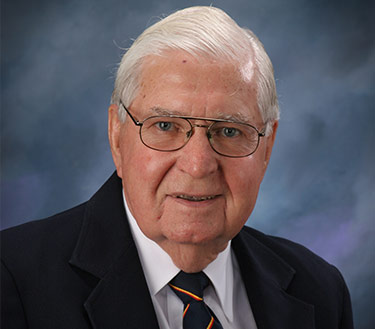Hendry, James R. W.

James R. W. Hendry
KMMCO
Inducted 2009
James Hendry (1921 – 2014) was perhaps the most prolific inventor of plastics processing technologies, with over 80 patents in that area. James was first employed by Burroughs Adding Machine Co., born in Scotland, where he ran compression molding machines and became an apprentice mold designer. In 1941, he joined Electric Autolite as a mold designer in Bay City, MI. He moved to Florence, MA, in 1944 to join the Pro-Phy-Lac-Tac Brush Company as chief mold designer. He was involved in converting a “standard” Lester torpedo injection machine into a two-stage molding machine. It had a stationary screw pre-plasticizer that melted plastic and conveyed it to a fixed-volume injection cylinder from which the plastic was injected into the mold. These changes increased the possible shot size to 64 ounces and allowed the company to mold significantly larger plastic parts, such as a battery case for a critical military application.
Hendy then became Manager of the Plastic Machinery Division of Jackson and Church, Saginaw, MI, in 1947 and later served as vice president there. During this time, he designed more two-stage injection machines. Hendry was awarded six U.S. patents for two-stage injection molding machine technology. He also patented the first machine that could be used to injection mold rigid PVC. This machine and know-how were the foundation of Tube Turns Plastics in Louisville, KY. This company pioneered the manufacture of rigid PVC pipe fittings and valves.
In 1959, Hendry joined the Marbon Chemical Div. of Borg Warner Corporation as Vice-president of the Equipment Division. He focused on developing machinery for the newly emerging structural foam process. He designed many structural foam molding machines with unique features and other patented plastic injection molding and extrusion processing equipment.
In 1970, Hendry became President of Ex-Cell-O Corporation’s Plastic Components Division in Athens, TN. During his time there, he designed innovative structural foam machines and set up the company’s custom molding plant, obtaining another 20 patents. It was apparent that the major drawback of structural foam, the swirl surface finish, could not be overcome with existing technology. Hendry began to focus on technologies to produce low-pressure injection moldings that would be stress-free and not exhibit swirls or sink marks. This focus was the start of internal gas-assisted injection molding.
Hendry started a small company in Detroit called KMMCO in 1981 and developed an early internal gas molding process named “Smooth Surface Technology,” later called “Gas Assisted Injection Molding.” Hendry then became an independent consultant specializing in developing advanced injection molding techniques, first working with Peerless Foam Moulding Ltd. in England on developing internal gas injection molding techniques. Several of his gas assist inventions were patented and assigned to Peerless, which eventually became “Cinpres,” a gas assist molding equipment supplier. Hendry also worked with Asahi Kasei, Sajar Plastics, Ford Motor Company, and finally, GAIN Technology, all in gas assist molding technologies. This work led to many patents being issued, often under challenge. Despite the many infringement suits between various companies, Hendry has been universally accepted as the originator of gas-assisted injection molding technology, having more than 20 gas-assisted molding patents.
By 1990, an entire industry had been created from Mr. Hendry’s gas-assisted injection molding inventions. Hendry recognized that the three biggest problems with gas molding were hesitation lines, shadow marks, and over-penetration of the gas. In 1994, Hendry began working on a new gas-assist molding process he named “External Gas Molding” to overcome these problems. James Hendry received numerous awards for his pioneering plastics molding work, including the Society of the Plastics Industry (SPI – now PLASTICS) Structural Plastics Division’s first “Pioneers Award” in 2002.
Areas of Expertise:
Plastic machinery, plastic processing

